- Home
- Helen Humphreys
Machine Without Horses
Machine Without Horses Read online
Dedication
For Nancy
Epigraph
From the bottom of the pool, fixed stars
Govern a life.
—“WORDS,” SYLVIA PLATH
Contents
Cover
Title Page
Dedication
Epigraph
Part One
Chapter 1.
Chapter 2.
Chapter 3.
Chapter 4.
Chapter 5.
Chapter 6.
Chapter 7.
Chapter 8.
Chapter 9.
Chapter 10.
Chapter 11.
Chapter 12.
Chapter 13.
Chapter 14.
Chapter 15.
Chapter 16.
Chapter 17.
Chapter 18.
Chapter 19.
Chapter 20.
Chapter 21.
Chapter 22.
Chapter 23.
Chapter 24.
Part Two
Blue Charm
Durham Ranger
Thunder and Lightning
Highlander
Wilkinson
Mar Lodge
Snow Fly
Silver Doctor
Popham
Jock Scott
Acknowledgements
About the Author
Also by Helen Humphreys
Copyright
About the Publisher
Part One
She has never seen a fish before. She stands in the shallows of the river, the water tightening its wire of cold around her knees, while her father calls her name from shore. She bends instead to the pattern of ripples on the surface, to the flutter of the salmon below, drifting slowly past her feet like large, dark birds.
1.
WHAT I CAN DO IN DARKNESS: MAKE LOVE, negotiate my way through the dim hallways of my house, talk on the phone, drink a glass of water. What she could do in darkness: tie a fishing fly.
It is the hottest summer I can remember. No rain for six weeks. The fields crisping at their edges, and the trees rattling with dry leaves, slowly dying from the ground up.
Perhaps it is this yearning for water that attracts me to the idea of her, to the real-life Megan Boyd, who tied exquisite salmon flies for sixty-odd years in a small Scottish cottage, without electricity or running water, and who, although she made the world’s best flies, never fished herself.
She said she made the lures for the fishermen, not for the fish—meaning that she had no desire to kill the salmon, yet her flies were helping the fishermen do just that. An odd logic, but that is what I find fascinating about her. She was a woman of extremes.
How do you become the best at something that you yourself have never tested? How do you separate an object from its purpose?
I am making notes about Megan Boyd—her life, the flies she made, the little bits of information that exist about her character—trying to tie these fragments into a story. I am sitting on my couch, with the ceiling fan turning its frantic circles above my head and the dog curled up beside me, while outside, the world bakes and shrivels. The brown grass has dried to needles. The roses are blown out against the fence.
I wasn’t looking for Megan Boyd as a subject to write about. As with so much of the writing life, she appeared by accident.
The onslaught of heat has made a lot of things impossible and it is difficult to be outside for any length of time. Usually, in summer, I spend all my hours outdoors, loathe to come inside even when it is dark. But now, forced to remain in the house, I have had to change my habits. One of the activities I decided on was to (finally) tidy my study, an upstairs room crammed with books and piles of papers and barely ever entered because it is too much of a mess and feels oppressive the instant I step through the door.
But there, in the first stack of papers I start through, is the New York Times obituary for Megan Boyd, given to me years ago by a friend who thought the famous fly dresser would make an interesting story, and filed away for future consideration.
The sun angles in the second-floor window, and the air through the screen is humid and close. I read the obituary. Megan Boyd is described as eccentric and a perfectionist. The fishing fly named after her is for use in the dead of summer, when the heat makes the salmon disinclined to bite.
I close my eyes and imagine standing in the cool shallows of a river. I cast my mind upstream, to the rock pools and the hills, to the low-roofed tin shed where Megan Boyd worked with such solitary dedication.
When I open my eyes again, my world has shifted.
The beginning of a life is often the start of the story. Character is formed from early incidents and accidents, from sudden trauma, or reassuring constancy. These are more important than aspects of personality because they are the ground on which the inherent nature of the person blossoms or is stifled.
Rosina Megan Boyd was born on January 29, 1915, in Surrey, England. She was the youngest of three children. In 1918, at the end of the First World War, her father took a job on the Sutherland estate near Brora, Scotland. The family moved with him, and Megan’s early life, and first real memories, took place in the remote and starkly beautiful landscape surrounding the River Brora.
In various accounts of Megan Boyd’s life, Megan’s father has been called a “baliff,” a “riverwatcher” and a “gillie,” so perhaps his job was a mix of all three. A baliff and riverwatcher are similar, in that the person undertaking these jobs has a custodial duty towards the river. He is on the lookout for people who are breaching the fishing regulations—poachers, and those who don’t have a valid licence or who are fishing out of season or exceeding the catch limits. A gillie is more of a guide to the fishermen. He will know the best places on the river to fish, the pools where the salmon rest during their journey upstream, and he will give advice on which flies to use given the weather and seasonal conditions.
It is a beautiful notion: watching a river for a job, for an entire working life, knowing the habits of the creatures that live in and along the water, determining the effects of weather and season on the workings of the river. It seems to me a perfect job, and while I do a little research on the River Brora, I let myself imagine Megan as a small child, trailing behind her father as he strides along the banks of the river or bends down to peer into a rock pool. He would have talked to her, shown her things, answered her questions. She would have seen the dark shudder of the salmon moving below the surface of the water, the trills of light played out on the ripples above. She would have heard the sound of the moving river, felt its coolness weave through her open fingers. Putting her hand to her mouth, Megan would have tasted the tang of the river on her tongue.
I moved when I was very young, and like Megan’s, it was a move from one distinct landscape to another. She moved from Surrey to Scotland. I moved from Surrey to Canada. I don’t know what the effect of the move was like for Megan, but for me it manifested in a strong need to attach myself to my new surroundings.
Megan attached to the River Brora so completely that she knew it as intimately as her father did and would advise the fishermen who came to buy her flies that they would need one fly if it was sunny out, a different one if it was cloudy, another for the rain, so subtle and definitive were the weather changes on the mood of the salmon.
The River Brora begins in the Ben Armine mountains in the north of Scotland and runs 165 miles to empty into the North Sea. It moves through Loch Brora, and the last three miles of the river are fast, with rapids and pools, as it hurries through the end of its journey. There are twenty named pools on the river, including one that is over two hundred yards long. Some of the names of the pools are descriptive or evocative:
Flats, Chemist’s, Snag, Madman and the Magazine. The salmon begin moving into the mouth of the river in late January and continue until the end of the season in mid-October, so, with various surges in the spring and early fall, there are almost continuous salmon on the River Brora.
The dog is restless, so I take her out. It’s too hot to walk across the brown, crunchy grass, and even too hot for the woods, so I take her down to a river near Kingston to swim. Charlotte has never been one to chase a stick, but she will splash around in the shallows, biting at the water for a while, and then, when she is good and wet, we can stroll slowly through the small patch of woods back to the car and both feel satisfied that we have had an outing.
It’s just the dog and me these days. Which is okay, for now. I’ve had five deaths in six years and the sudden gust of that has made me feel wobbly, off balance, not able to do much more than take the simplest path through my days. Animals are good for sorrow because they don’t make a fuss about anything and have fairly uncomplicated expectations for the day-to-day.
Maybe I like the idea of Megan Boyd because I can picture her colourful, beautiful lures arcing out of the darkness towards me in a simple, perfect line. And like the salmon, I want to leap towards the fly, marry it, swallow it, because its brightness feels like an answer to sadness.
Megan’s father presented her with her first salmon fly when she was a child. She thought it was “pretty.” That was her word for it. The fly was a Blue Charm, a popular low-water summer fly from the early years of the twentieth century. The blue, from a tiny piece of cockerel feather, was apparently attractive to the salmon in the blue light of early morning.
Starting a book is like starting a love affair. It demands full and tireless attention or feelings could change. Commitment takes time, and so there must be a rush of passion at the beginning. This means that the other life of the writer, the “real life,” has to fade into the background for a while. In the past I have found this difficult, but now it is a relief. At the moment, real life is overrated and I am happy to think about the River Brora and to imagine Megan’s childhood near it.
2.
MEGAN LEARNED TO TIE FLIES AT THE AGE of twelve from Bob Trussler, a gillie who worked with her father on the Sutherland estate. Trussler took apart salmon flies and then made Megan reassemble them, using smaller and smaller hooks. She must have shown promise at the task and received praise from both men, for she seemed to have made the decision that fly-tying would be her vocation from this early game. She left school at fourteen and left home at twenty. Her first job, furnished through her father, was to repair or re-tie all the salmon flies in a fisherman’s tackle box, for which she was paid five pounds. With this money, she bought her father a new three-piece wool suit from the Army and Navy Stores in London and still had enough cash left over to purchase the materials she needed to set herself up in business.
She lived in a small cottage on the Kintradwell estate, a few miles up the road from Brora. The cottage had no electricity or running water. Megan tied her flies in a shed on the property, using a kidney-shaped dressing table as her work surface. Aside from the lessons from Bob Trussler, she depended on advice from the classic volume How to Dress Salmon Flies: A Handbook for Amateurs by T.E. Pryce-Tannatt and published in 1914. She called this book her “bible.”
Initially, Megan’s father and Trussler supplied her with clients for her salmon flies, from the collection of fishermen who hired them as guides on the River Brora. But soon, she was attracting clients from elsewhere as her reputation for tying perfect salmon flies grew and spread. In the middle of her life, at the height of her fame, Megan Boyd had orders from all over the world and was operating on a four-year backlog.
Why do we do the things we do? Why do we have the jobs we have? Choice or lack of choice. Circumstance and opportunity. Realizing that you are good at something is a strong motivation to continue. It is hard not to take praise to heart and be encouraged by it. Perhaps pleasing her father and Bob Trussler by tying “pretty” salmon flies was enough for Megan. She never felt the need to look elsewhere for her purpose in life. She had approval for what she did, and a built-in client base. It seems like a practical choice. And yet it was also bound up in sentiment—her relationship with her father, who others said was miserable and cantankerous, her attraction to the “pretty” pattern of the Blue Charm, its delicate, intricate balance of feather and thread.
Making a salmon fly is about doing it right. It is about constructing something absolutely perfectly and then being able to replicate that act over and over again. It is also about knowing the fish and what they will and won’t like. The salmon who run the rivers aren’t there to feed. They have done their feeding for years in the North Atlantic, gorging on sand eels, krill and herring. Now they are on their way back up the rivers they were born in, to spawn. So, they are not responding to a fishing fly out of appetite. They do not need to take it, thinking it is an insect. They are not operating from hunger, which is probably the level we are all operating from most of the time—physical hunger for sustenance, but also emotional hunger, sexual desire, and even spiritual hunger. So, what does it mean to choose to take something that you don’t want or need?
Megan had a theory that the salmon retained memories of the young aquatic insects they had eaten in the rivers when they were young parr, and that they would take a salmon fly because it triggered this memory. They had returned to the rivers they were born in by remembering the particular scent of their native river, and in entering that river they were entering their own pasts, so it makes sense that they would respond to something that reminded them of that past.
So highly did Megan regard the judgment and instincts of the salmon that she would never cut a feather or bit of fur, because a cut mark is not natural and the fish would recognize that and leave the fly alone.
When I set about making a story, one of the first things I think about is the motivation of the main character. What is it that they want? What are they driven by? Story is created from combining a character’s motivation with their circumstances. For example, if a character wants to be rich and they are born into abject poverty, then the story is about their struggle to achieve what they desire, with their motivation set against their circumstances. If they succeed, the story is a triumph. If they fail, it is a tragedy. The more extreme the distance between the motivation of the character and the situation they find themselves in, the more epic the sweep of the story.
What did Megan Boyd want? What did tying salmon flies give her that she couldn’t get elsewhere?
It’s a question I can’t easily answer, so I make a move sideways. I have decided that I should take some fly-tying lessons myself, in order to better understand what Megan Boyd did, and so I spend the rest of the morning following leads until I have found someone to teach me. I make an appointment for the next day and then take the dog out through the woods. It is still stiflingly hot, but it feels good to be away from the house.
The ground is cracked along the forest path, deep fissures splitting the earth. I drop a small pebble down one of them and it disappears. No sound of it hitting the bottom of the rut.
At the river, I look for salmon, even though I know it is too early in the season. The salmon still run this city river, in spring and fall, arching their bodies against the current upriver, on their way to spawn. I like to watch them muscling through the water, negotiating the rocks and each other, and the fishers who stand in the river, arcing their lines upstream.
Dog walkers are routine creatures, and I often recognize them by their dogs and the time of day they are out. At a bend in the river, I meet the French bulldog, George, and the man who owns him. I usually see them at least once a week. We stand politely for a moment, exchanging pleasantries as our dogs sniff each other, and then we all break apart and continue our walks. It is not unusual, as a dog owner, to know George’s name and not know the name of the man who accompanies him.
At night, I lie in bed and think of wha
t Megan could want, what her motivations were. Praise? Is this enough to fuel a whole lifetime? I’m not sure. The work of tying flies would be monotonous, full of repetition, hard on the eyes and hands. I imagine her hunched over her makeshift workbench with the sun slanting in the window—for she only worked in natural light, starting when the sun rose in the morning and ending her day when it set at night. She has the fishing hook fixed in the vise and is winding the first layer of black thread onto the shank. Next, she will add a tiny bit of feather or a thin strip of silver tinsel. Perhaps she is listening to the radio while she works. (There is a radio on the shelf behind her desk in one of the photos I have of her fly-tying shed.) Maybe her dog is there, keeping her company. In another photo I have seen of her workspace, her border collie, Patch, sits right beside her, watching carefully as she ties a lure, looking more like a reproachful assistant than a pet.
There is a rhythm to the work, a familiar rhythm, and she can enter it the way one enters a river, letting it wash over her. The angle of sunlight. The winding of the thread over the hook. Voices on the radio. The presence of the dog. Company and solitude. The habit of familiar work in the changing light of a new day. What did she make of it all? What were her thoughts?
I turn over and watch the street light out the window, the way it haloes the little piece of pavement at its base. Megan Boyd would have turned in bed and seen only blackness out of her window—a spill of stars on a clear night, and the soft hush of the sea beyond her garden.
3.
MY BROTHER.
My father.
Three close friends.
(Not in that order.)
(My dog, who, I know, is not the same as a person, but thirteen years . . . )
4.
THE SALMON FLY–TYING TEACHER’S NAME IS Paul. He lives an hour away, in a neat bungalow on the weedy end of a small lake. He comes out to meet my car as I negotiate between the tidy flower beds, full of white gravel and wilted geraniums.

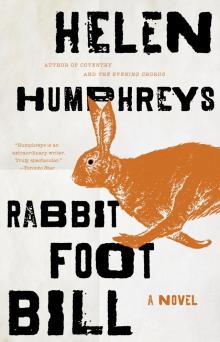 Rabbit Foot Bill
Rabbit Foot Bill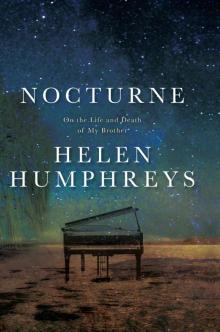 Nocturne
Nocturne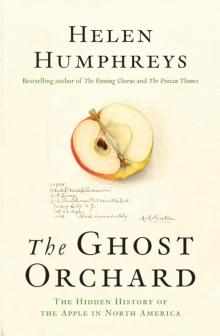 The Ghost Orchard
The Ghost Orchard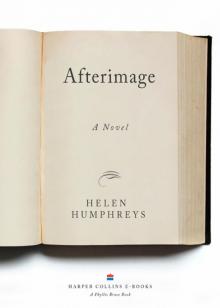 Afterimage
Afterimage The Frozen Thames
The Frozen Thames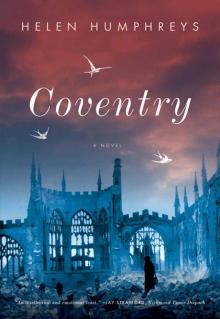 Coventry: A Novel
Coventry: A Novel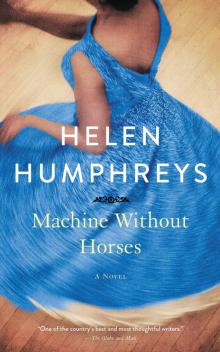 Machine Without Horses
Machine Without Horses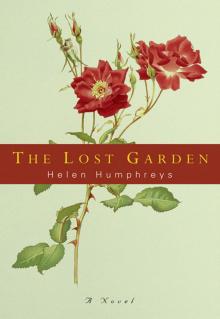 The Lost Garden: A Novel
The Lost Garden: A Novel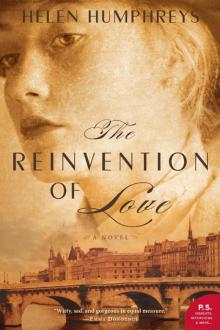 The Reinvention of Love
The Reinvention of Love Helen Humphreys Three-Book Bundle
Helen Humphreys Three-Book Bundle